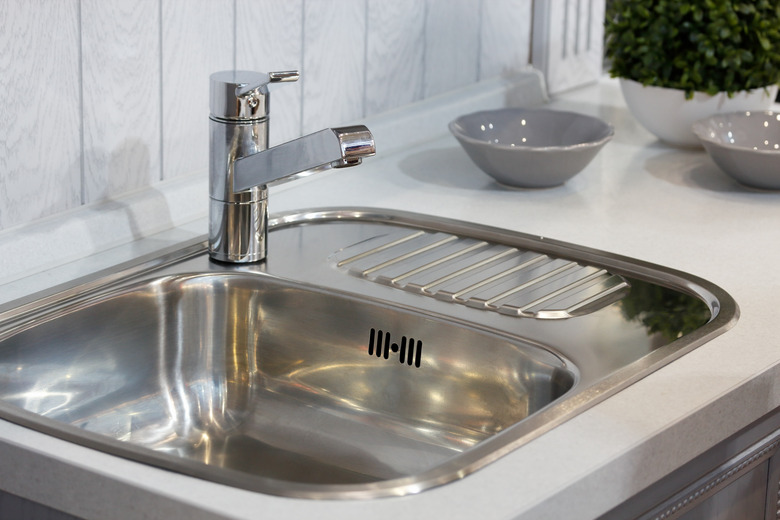How To Remove Calcium Deposits From Stainless Steel Sinks
Calcium, limescale or water spots: No matter what you call them, deposits and hard water spots on a stainless steel sink can leave it looking dirty, even after you've just cleaned it. These mineral deposits, left behind when tap water evaporates, are far more obvious in a steel sink than in a white, porcelain sink. To get rid of these hard water spots, try a simple cleaning with white vinegar.
Homemade Limescale Remover
Homemade Limescale Remover
White vinegar serves as an excellent limescale remover, dissolving hard water spots on a stainless steel sink surface. Once a sink is already clean, spritz or pour a little white vinegar atop each calcium deposit. Wait five minutes, then wipe the vinegar away with a damp sponge. Dry the area with a paper towel afterward.
While you could dilute the white vinegar, this acidic substance works best in pure form. Besides, diluting it too much with tap water could contribute to additional water spots, since tap water caused the issue in the first place. White vinegar also works wonders when it comes to removing mineral deposits around the faucet spout and aerator. Pour some white vinegar into a zippered sandwich bag, then place the bag over the spout so it covers the mineral deposit. Attach the bag to the faucet with rubber bands. Remove the bag after an hour or so, then pour the vinegar down the drain.
Read more: How to Refurbish a Stainless Steel Sink
Removing Spots Around the Drain
Removing Spots Around the Drain
The area around the drain and the garbage disposal entrance are prime locations for limescale buildup, especially around the perimeter of the drain collar. To treat this buildup, fold a paper towel into quarters, wet it with white vinegar, then set it atop the drain collar. After about 10 minutes, wring out the paper towel, then use it to wipe the area around the drain collar.
Wipe the area with a dry paper towel. If you still see water spots or other buildup, scrub gently with a nylon scrub brush or old toothbrush. According to Just Manufacturing, a nylon dish-scrubbing pad also works. Rinse the area, then pat it dry with a paper towel.
A More Thorough Cleaning
A More Thorough Cleaning
If the sink is full of limescale buildup or could otherwise use a good cleaning, pour some baking soda into a bowl, then add just enough water to make a paste. Dip a damp sponge into the baking-soda paste, then rub it all over the sink bowl, following the direction of the buffed-in marks on the stainless steel. Once you've coated the entire sink bowl, spritz it with a generous amount of white vinegar.
The vinegar and baking soda cause a reaction that foams and helps lift away grime, limescale and other buildup. Wait several minutes, then wipe the sink down with more vinegar, or simply rinse it out with water. Wipe it dry with paper towels. This homemade stainless steel sink cleaner works as well as many commercial products without any potentially harmful chemicals.
Add a little shine to your clean sink by rubbing it with a few drops of olive oil, applied with a paper towel.
Read more: How to Clean a Dull Stainless Steel Sink
